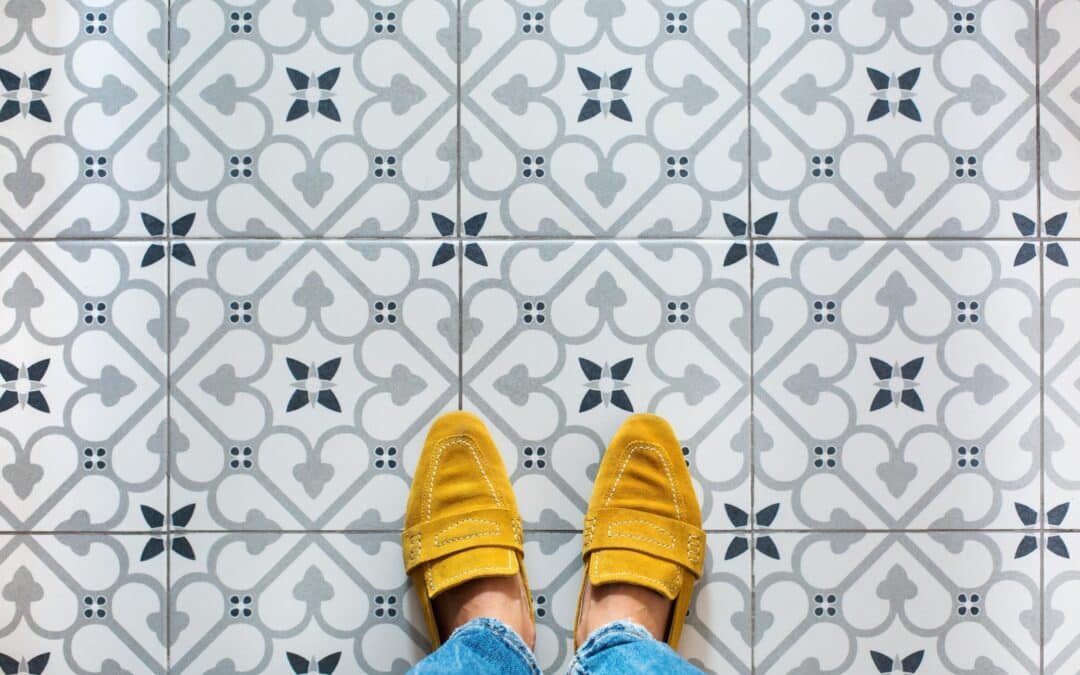Like a chess grandmaster contemplating their opening move, the selection of tiles sets the strategic tone for a home’s aesthetic and functionality. Tiles are the unsung heroes of interior design, offering both functionality and aesthetic appeal. From the kitchen backsplash to the bathroom floor, tiles play a crucial role in defining the look and feel of a space. In this article, we’ll explore the different types of tiles, including materials, patterns, design influences, and utility, as well as share how a designer can help you create a cohesive and functional home with the right tile selections.
However, navigating the myriad of tile options presents the daunting challenge of how to choose the right tile for your home, often leaving them stranded in a sea of porcelain, ceramic, and stone possibilities.

Tile Types Decoded
Embarking on the voyage through the vast ocean of tiling choices necessitates a refined grasp of the core categories that frame the industry: ceramic, porcelain, stone, and glass tiles, each distinct in their composition and endowment of properties. Ceramics, birthed from kiln-fired clays, offer a versatile and cost-effective solution, while their porcelain counterparts, fired at intensely higher temperatures, boast enhanced durability and moisture resistance. Natural stone tiles, hewn from the very bedrock of the earth, exude timeless elegance and resilience, with variegations unique to each quarry. Glass tiles shimmer with luminosity, lending a modern sophistication and bespoke palette that can embolden any space. Selecting the appropriate type transforms your environment into a testament to personal style and practical wisdom.
Ceramic vs. Porcelain Tile
Ceramic tiles, known for their diverse designs and affordability, cater to various aesthetic preferences, offering a practical flooring option. Porcelain tiles, similarly versatile, exhibit greater density and durability, making them suitable for higher-traffic areas and commercial applications.
Porcelain tiles’ dense nature stems from their refined clay composition and higher firing temperatures. This process gives them a less porous structure than ceramic tiles, leading to superior resistance against moisture, stains, and wear.
Porcelain is highly praised for its exceptional longevity in demanding environments.
~ Tiffany Hanken, Interior Designer
Both materials require consideration of context: while ceramic tiles may suffice for residential settings, porcelain exceeds expectations in both residential and commercial spaces. When selecting between the two, one must weigh factors such as foot traffic, moisture exposure, and long-term usage expectations to determine the ideal choice.
Ceramic Tile in a THD Project
Below are samples of ceramic tile that Tiffany Hanken Design used in recent home design projects. The tile was sourced from Ceramic Tile Works. The Wallpaper was sourced from Cowtan & Tout.
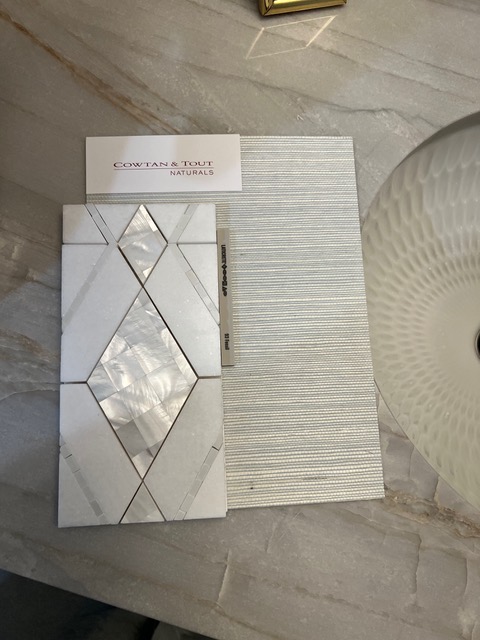
Natural Stone Varieties
When exploring natural stone options, it’s critical to recognize their distinct textures, durability, and colors unique to each type. Granite, for instance, stands out for its hardness and granular appearance.
Marble exudes an elegant, veined pattern, synonymous with luxury and prestige. Its softness requires careful consideration for placement and maintenance to preserve its lustrous appeal.
Travertine, though less renowned than granite or marble, offers an appealing earthy tone with a porous surface, often likened to a more subtle version of marble. Suited for both indoor and outdoor environments, it elevates spaces with a hint of Roman grandeur and timeless elegance.
Slate, with its natural cleft texture and robustness, serves as both a traditional and contemporary choice for residential and commercial spaces. In the realm of limestone, its sedimentary origins bestow a softer and typically more uniform palette, making it an excellent canvas for refined aesthetic expressions. Increasingly popular, sandstone brings a “beach-like” ambiance, adding warmth and a natural feel to design schemes.
For a look into some interesting natural stone projects, take a peek at Minneapolis/St. Paul-based Mosaica projects, which specializes in the commercial fabrication and installation of natural stone.
Cutting-Edge Glass Tiles
Glass tiles, recognized by their translucency and vibrancy, infuse any space with a modern and sophisticated aura. Their light-reflecting properties enhance the brightness of a room, casting an ambiance of openness and clarity.
Distinctly versatile, these contemporary marvels grace various settings, from kitchen backsplashes to bathroom walls, offering unparalleled aesthetic versatility. When illuminated, glass tiles can transmit and reflect light, creating an interplay of luminescence that magnifies the depth and color of the tile. They are made using cutting-edge techniques to ensure durability and provide ease of maintenance, allowing them to maintain their lustrous beauty over time.
However, careful consideration is needed when incorporating glass tiles into design plans. Their reflective surface may magnify imperfections, necessitating precise installation and a well-conceived design strategy to maximize their visual appeal. Additionally, their cost, which can supersede those of conventional tile materials, is a key factor in budgetary planning.
For designers attentive to sustainability, glass tiles increasingly feature recycled materials, aligning with eco-friendly design trends. In addition to their visual appeal, these tiles hold the advantage of being non-porous, resisting stains and moisture. Such attributes make them ideal for high-moisture areas like showers and pools, simultaneously promoting an aesthetically pleasing environment and sustaining hygienic standards.
Mosaic Tiles
Mosaic tiles exude artistry and intricate detail.
Mosaic tiles are a time-honored, versatile décor element. They offer boundless creative scope within design schematics, often comprising glass, ceramic, stone, or other materials fashioned into small pieces arranged in diverse patterns. Functionally, they dazzle as focal points or enhance spaces with their textural dimensions. Mosaic tiles infuse spaces with a distinct artfulness and a touch of opulence.
Inherently resilient, mosaics withstand extensive wear.
The installation process for mosaic tiles requires precision. Without meticulous placement and grouting, the result could lack the desired uniformity and symmetry. Suitable subflooring and adhesive selection are paramount to ensure long-lasting and aesthetic installations.
Mosaic tiles can transform even the humblest of spaces.
Incorporating mosaic tiles into home design continues to be a burgeoning trend. Their adaptability allows them to span from classical to contemporary settings, bridging the gap between traditional craftsmanship and modern design expressions. The 2023 home design landscape frequently showcases mosaic tiles as functional art pieces, integrating personal style with practical considerations for spaces that captivate.
Before/After Kitchen Remodel
The below photos are before and after images of a kitchen that Tiffany Hanken Design was hired to do. The right image showcases mosaic tiles from the Tile shop.
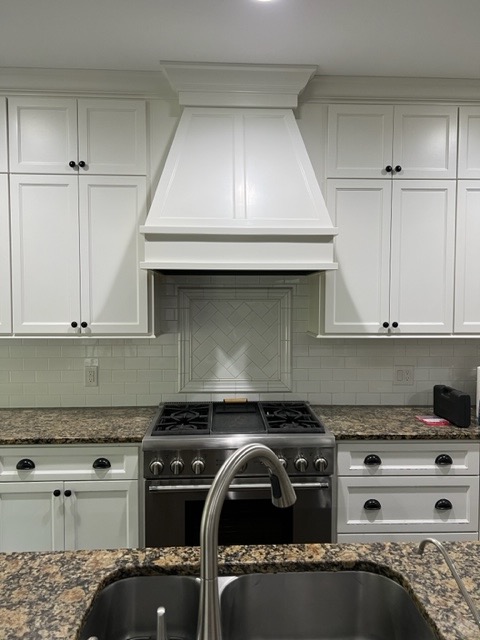
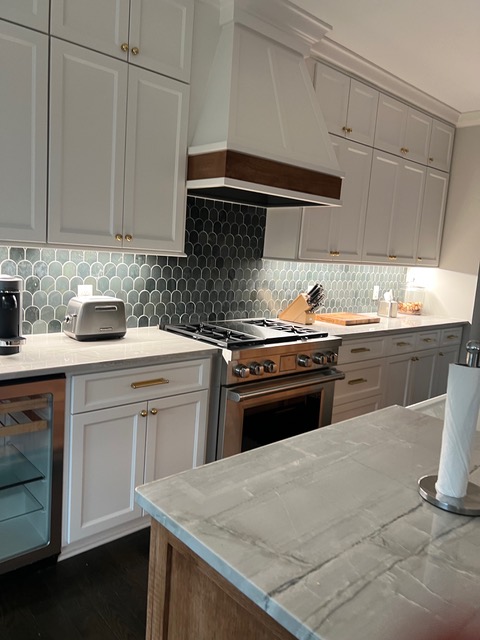
Selecting the Right Material
When choosing tiles for your space, it is crucial to contemplate the material’s inherent traits, which include durability, maintenance requirements, and aesthetic appeal. Porcelain and ceramic are predominately selected for their hard-wearing properties, making them well-suited for high-traffic areas. Natural materials such as marble and slate add a distinct and luxurious touch but may require more care and upkeep.
Selecting a tile material is not merely a functional choice but also a design statement. Think of it as a “canvas of expression”. Different materials resonate with the atmosphere of a space—their texture, color, and finish contribute to the overall interior story. While porcelain offers a vast range of design versatility, natural stone brings with it an inherently unique distinction. In the end, weighing the material’s functionality against its contribution to the aesthetic essence of the space is vital for a harmonious and lasting design.
Assessing Durability for High-Traffic Areas
For areas with frequent foot traffic, assessing tile durability is paramount to ensure longevity and appearance.
- PEI Rating: Consider the Porcelain Enamel Institute (PEI) rating which assesses abrasion resistance and surface wear of glazed tiles.
- Coefficient of Friction: Ensure slip resistance by examining the coefficient of friction (COF) values; higher numbers provide better traction.
- Water Absorption Rate: Opt for low water absorption tiles for areas susceptible to moisture; this reduces the potential for cracking and mold growth.
- Thickness and Body Composition: A thicker tile with a robust body composition stands up better to heavy use.
- Mortar and Grouting: Select high-quality mortar and grout that can endure the demands of high-traffic usage. Aesthetic elements should align with durability features to strike a balance between form and function. A professional installation is critical to harness a tile’s full durability potential, especially in high-traffic environments.
Moisture Resistance in Wet Environments
In wet environments, selecting the right tile material is crucial for preventing water damage and mold growth.
- Porcelain: Highly impervious to moisture due to its dense nature.
- Glazed Ceramic: Offers a protective layer that resists moisture and staining.
- Glass Tiles: Non-porous and excel in resisting moisture.
- Vitreous Tiles: Specific ceramics with low water absorption rates, suited for consistent moisture exposure.
- Natural Stone: Options like granite and slate have lower porosity, but require sealing for optimal moisture resistance. Choosing the proper tile entails considering its Water Absorption Rate and inherent material properties. For safeguarding integrity in moisture-prone areas, a professional installation, including appropriate waterproofing measures, is imperative.
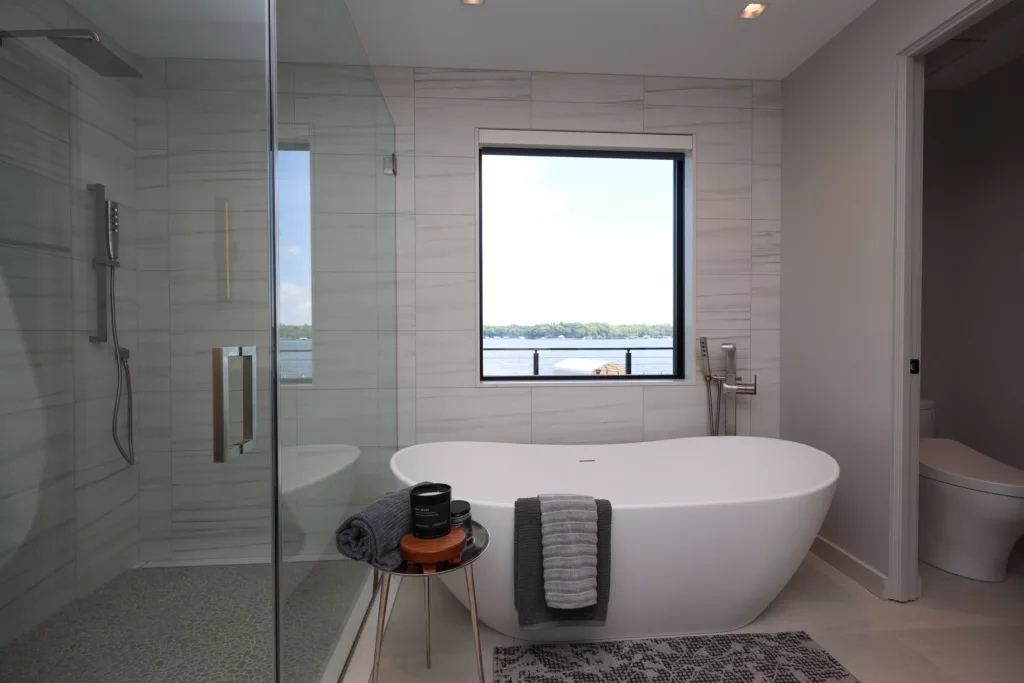
Eco-Friendly Options for Sustainable Homes
Eco-conscious homeowners seek materials that reflect a commitment to environmental stewardship. Thus, the emergence of sustainable tile options—crafted from recycled content, sustaining a tile’s lifecycle while minimizing environmental impact—is a welcomed innovation.
Recycled glass tiles are a popular eco-friendly choice, offering vibrant aesthetics alongside their green credentials.
Sustainably sourced ceramic tiles use less energy and resources in production, making them a smart, eco-conscious investment.
Biodegradable materials, such as bamboo or cork tiles, present renewable solutions that harmonize with an organic design ethos, bolstering a home’s green quotient.
In the realm of natural stone, salvaged options ensure that no new quarrying is necessary, extending the life of existing material while reducing the environmental footprint of your home upgrades.
Lasting durability is a bedrock of eco-friendly tiling; investing in quality means fewer replacements and a longer lifecycle for each tile applied.
With these considerations, one can craft a home space that embodies eco-responsibility while exuding sophistication and durability, setting a precedent for sustainable luxury.
Choosing Patterns
Pattern selection is a keystone in the tile design process, dictating ambiance and spatial perception. Intricately designed patterns can serve as focal points or demarcate distinct areas within a space, blending form with function.
Conversely, uniform patterns project a sense of continuity, ideally suited for minimalist or contemporary environments. When selecting a tile pattern, consider the interplay of scale, repetition, and alignment, all of which dictate the final aesthetic. Harmonizing pattern choice with the overall design vision ensures a cohesive and pleasing environment.
France Project: Tile Pattern Choices
In our current full-home interior design project in France, we visited Maison Carrelle to pick out these awe-inspiring patterns to use in our project.
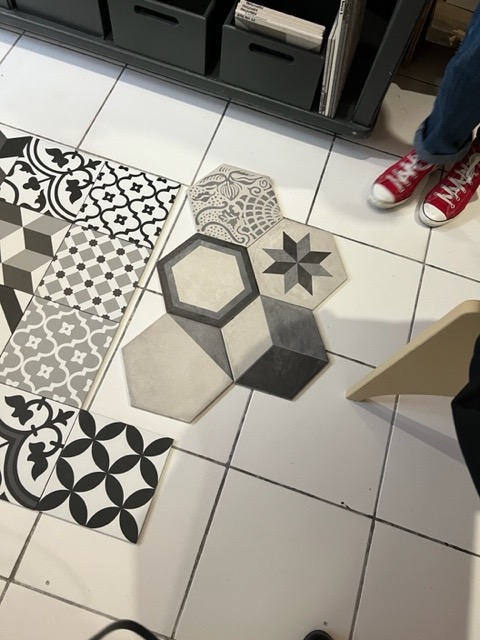
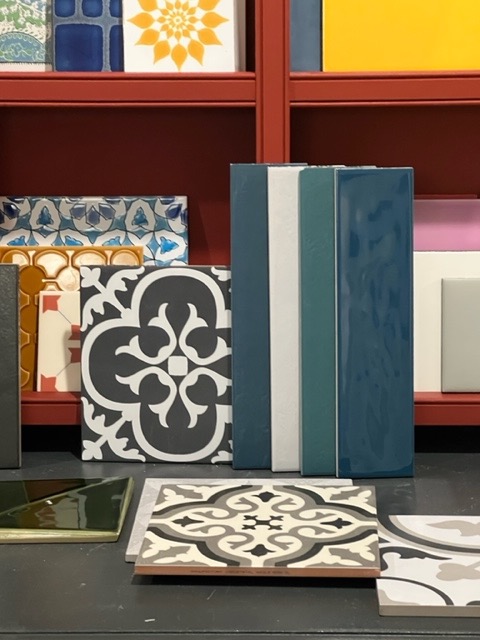
Design Influences
Tiles do more than surface a space; they express a narrative, speaking to the aesthetic and historical context within which they’re placed. As a mirror of cultural and artistic movements, tiles can enhance the character of a room, drawing on influences ranging from the ornate patterns of the Moorish era to the sleek lines of contemporary minimalism. In discerning the appropriate design influence, one must consider the architecture, purpose, and desired ambiance of the space, ensuring that the tile selection not only complements but elevates the existing interior narrative.
Color and Pattern Harmony
Crafting a visually harmonious space necessitates a thoughtful consideration of both color and pattern. The chosen palette should complement the room’s furnishings and fixed elements while echoing its overarching style.
In selecting tile hues, it’s essential to understand color theory and its psychological impact. Colors can set the mood, with cool tones imparting calmness and warm shades injecting energy, thereby influencing the atmosphere of the space.
Equally critical is the coordination of patterns, which requires an astute balance between boldness and subtlety. A judicious use of patterns can create focal points or unite disparate elements within a room.
Refining the interplay between tile patterns, colors, and room elements maximizes aesthetic appeal. It’s about finding the right mix that speaks to the intended design narrative while ensuring longevity and timelessness.
Ultimately, achieving color and pattern harmony is about crafting a cohesive narrative that enhances the space without overwhelming the senses. This equilibrium is the hallmark of a sophisticated and well-executed design strategy.
Size and Shape Considerations
The dimensionality of tiles plays a pivotal role in the perceived spaciousness and harmony of a room. Choosing appropriately proportioned tiles can greatly influence the aesthetic and functional outcome of your tiled surfaces.
When considering tile size, it is essential to be cognizant of the room’s scale. Large format tiles can create a seamless and expansive look, especially in more substantial areas, while smaller tiles may be more fitting for cozy or intricately designed spaces. This choice can significantly affect the room’s visual flow and should be made with close attention to the existing architectural features.
Furthermore, shapes, and patterns of tiles can transform the ambiance of a room. Geometric shapes like hexagons or herringbone patterns add a contemporary edge, while classic rectangles or squares evoke a more traditional feel. Each shape carries its own visual weight and directional influence, potentially affecting a room’s perceived geometry and spaciousness.
Lastly, it’s crucial to contemplate the tile design’s functionality alongside its aesthetics. For wet areas, such as bathrooms, smaller tiles with increased grout lines can offer better grip, reducing slip hazards. Meanwhile, for areas where continuity is paramount, larger tiles with fewer grout lines can create a more fluid appearance, reinforcing the design’s overall cohesiveness and sophistication.
Grout as a Design Element
The choice of grout color and texture can accentuate or soften the visual impact of your tile work.
- Contrast Grouting: Opting for a grout color that sharply contrasts with your tiles highlights the pattern and shape, infusing a graphic appeal.
- Harmonious Grouting: Selecting a grout hue similar to the tile color offers a subtle, sophisticated look that blends seamlessly with the tile pattern.
- Textural Variation: Utilizing grouts with different textures can introduce a tactile element, enhancing the sensory experience of the tiled surface. Grout width is pivotal, influencing the spatial perception of tiled areas. Grout is not merely functional; it’s an integral part of the tile design, contributing to the overall aesthetic and character.
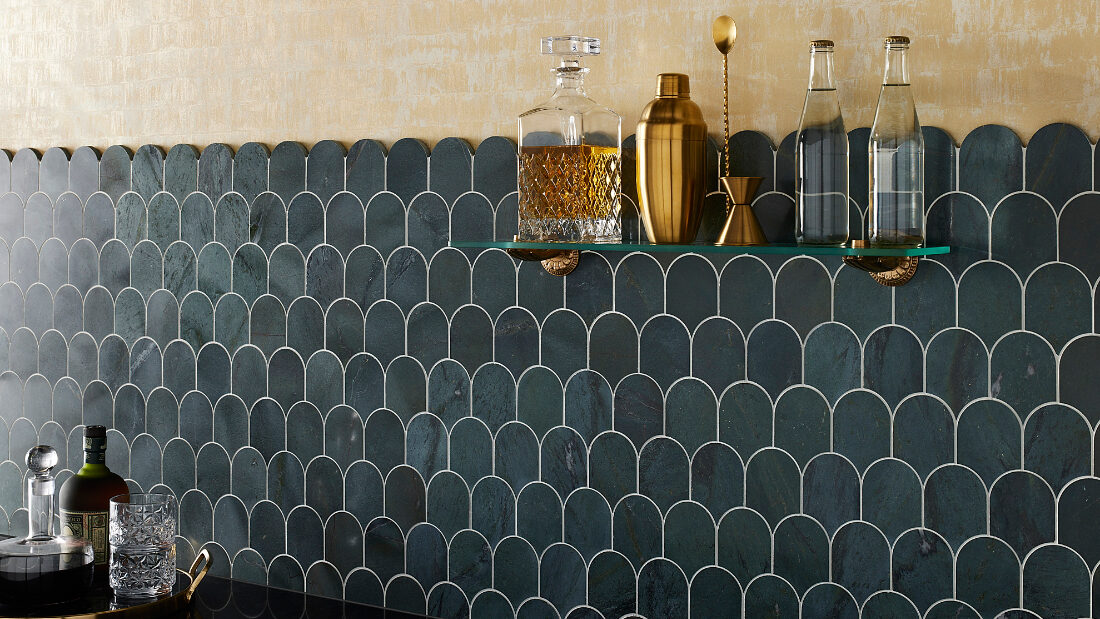
Utility and Use
Tiles serve as more than mere surface dressing; they combine durability with elegance, providing a foundation for environments intended for both activity and relaxation. From providing a durable surface for high-traffic areas to creating a serene backdrop for tranquil spaces, tiles are the bedrock of a space’s functional and aesthetic appeal.
As with art, the ideal selection of tiles demands a consideration of context and purpose – whether to accent an architectural detail with mosaic intricacies or to bestow a room with the grandeur of large-format slabs. Each choice in tile type, size, and placement is a meticulous decision influencing a room’s ambiance and practical use.
In today’s design lexicon, terms like “anti-slip” and “frost-resistant” define tiles by their functional capabilities, distinguishing them within a matrix of suitability for various applications. These specifications are not mere details; they are essential in shaping the utility and life of tiled environments.
Durability
When considering tile selection, durability is a paramount factor. It encompasses the tile’s ability to withstand foot traffic, moisture, and mechanical impact without losing its aesthetic.
Tiles manifest their durability through a confluence of composition and finish. For high-traffic zones, such as commercial spaces or residential entries, choosing a tile with a high PEI (Porcelain Enamel Institute) rating ensures that it can endure heavy use. Similarly, vitrified tiles offer unparalleled strength and moisture resistance, making them suitable for both indoors and outdoors.
Additionally, the hardness of tiles, as rated by the Mohs scale, dictates their resistance to scratches and chipping. Porcelain tiles, for instance, possess a greater hardness than ceramic tiles, making them a more durable option for flooring that must remain pristine amid daily wear and tear.
Lastly, tiles must also resist environmental stressors such as thermal expansion and chemicals. For areas subject to extreme temperature variations, thermal shock-resistant tiles maintain integrity without cracking. In chemically exposed areas, such as kitchens and laboratories, tiles with low porosity prevent absorption of stains and corrosive substances, ensuring long-term visual appeal and structural soundness.
Water Resistance
Water resistance is an indispensable characteristic of tiles, particularly in moisture-prone areas like bathrooms and kitchens. It’s essential that tiles selected for such spaces possess the ability to repel water effectively to prevent mold growth and structural damage.
Porcelain tiles are renowned for their low porosity, making them virtually impermeable to water. This is why they are often preferred for areas exposed to moisture.
Glazed ceramic tiles, while not as impervious as porcelain, still offer adequate water resistance due to their protective top layer. This glaze acts as a barrier against water penetration, helping to preserve the tile’s appearance and integrity over time.
For optimal water resistance, it is critical to ensure proper tile installation with high-quality grout and sealant. These materials fill the spaces between tiles, preventing water from seeping through and causing damage beneath the surface. Furthermore, ongoing maintenance, such as periodic resealing of the grout, can bolster a tile’s water-resistant properties, safeguarding your investment in both the aesthetics and longevity of your tiled surfaces.
Heat Resistance
Tiles are a pragmatic choice for areas where heat resistance is paramount, ensuring both safety and durability.
- Ceramic and Porcelain tiles are known for their excellent heat resistance, often used for fireplaces and hot climate flooring.
- Quarry tiles are another option that withstand high temperatures, suitable for outdoor spaces and commercial kitchens.
- Natural stone tiles, like granite and slate, not only resist heat but also add a distinct natural appeal to any setting.
- Glass tiles are less common but can be used where moderate heat resistance is needed and aesthetics is crucial.
The inherent thermal stability in these materials makes them ideal for environments subjected to heat exposure.
Tiled surfaces maintain their integrity and appearance when exposed to heat, a testament to their resilience and practicality in design applications.
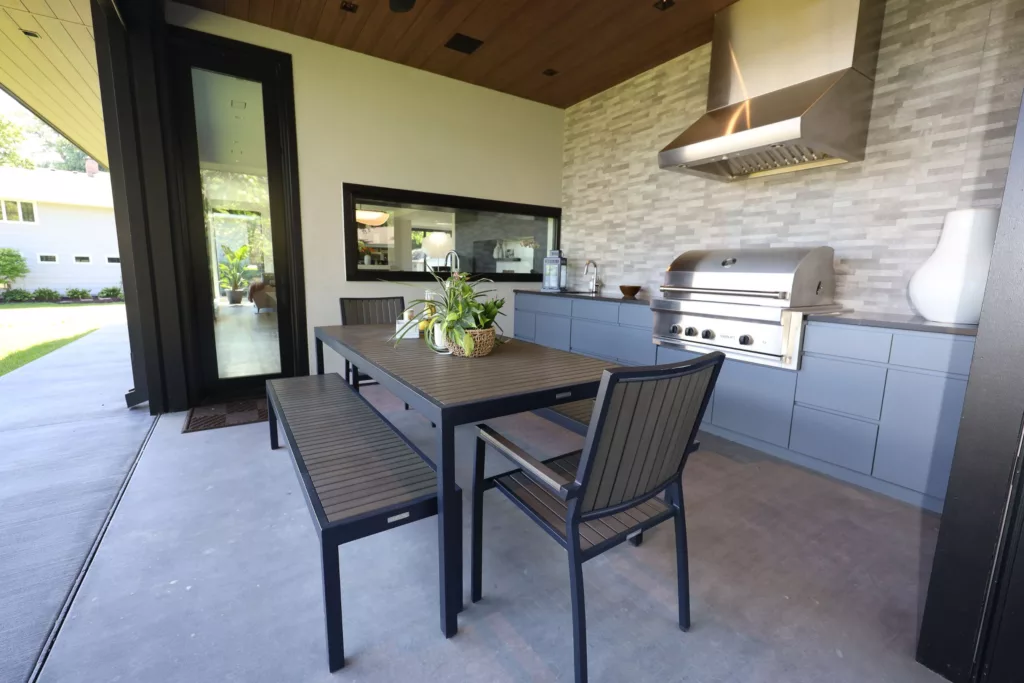
Here is a close look at the textured porcelain tile used in the above project. The tile and images are supplied by tilebar.
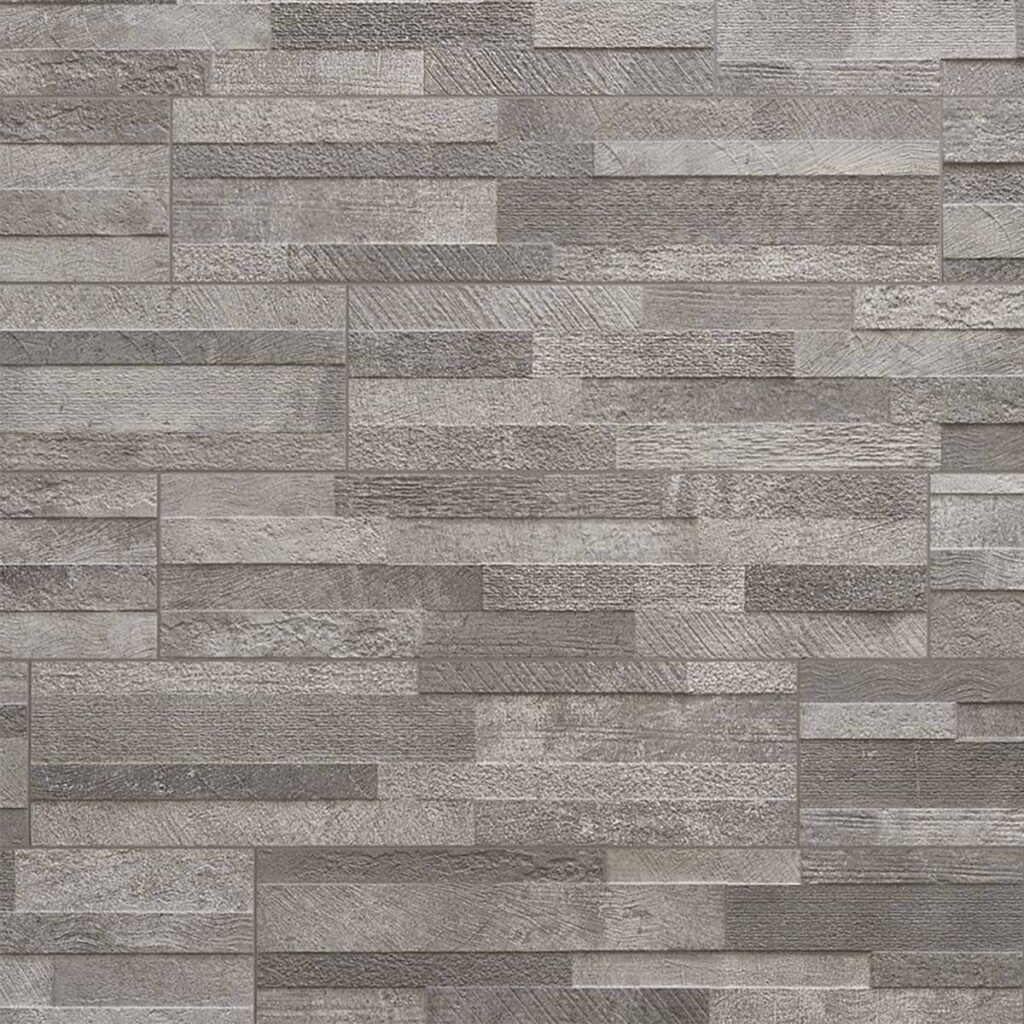
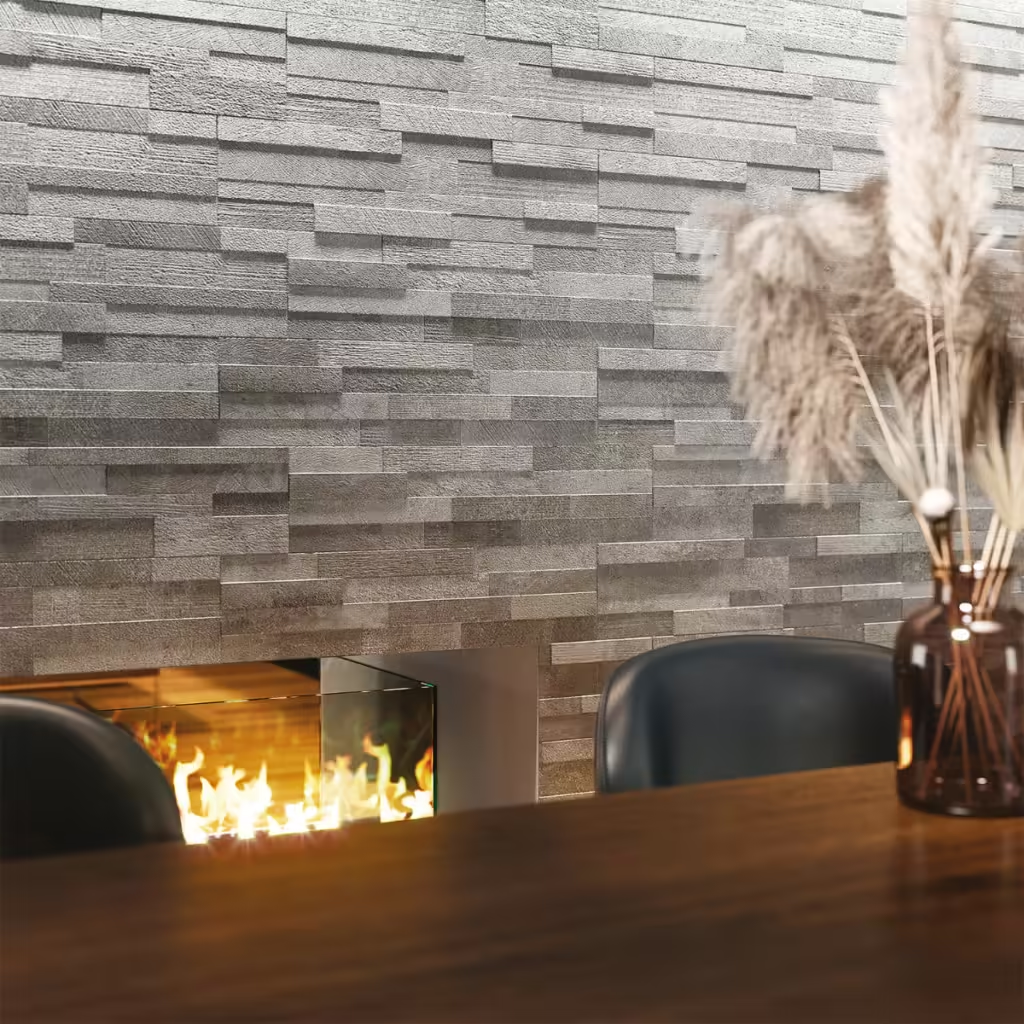
Versatility
Tiles adapt gracefully to diverse applications.
Their application extends far beyond just kitchens and bathrooms. From flooring to backsplashes, tiles offer a myriad of design possibilities. They can be incorporated into various rooms and spaces, each time providing a unique aesthetic. Crucially, tiles are not confined to interior use; they often find their rightful place in outdoor settings.
Harness unmatched design flexibility with tiles.
Tiles serve a dual purpose – as practical surfaces and design statements. Through different textures, colors, and patterns, tiles can anchor a space or complement existing design elements, demonstrating their dynamic and multifaceted nature.
Explore a world where function meets creativity, effortlessly.
Tiles offer unparalleled options in customization and adaptability, setting the stage for ongoing innovation in interior design practices. With the latest trends of 2023 leaning towards maximalist patterns and sustainable materials, tiles continue to evolve, solidifying their place as quintessential elements in modern interiors.
How an Interior Designer Can Help
An interior designer brings a comprehensive vision to the table, harmonizing aesthetics with functionality. They intricately understand spatial dynamics, which allows them to suggest tile proportions, color schemes, and textures that will enhance the charm and practicality of your environment. With their expertise in current trends and timeless design principles, they effectively navigate the expansive landscape of tile options.
Their specialized knowledge is invaluable in selecting the right tiles for the intended application and ambiance. An interior designer ensures that the selected tiles not only align with your stylistic preferences but also possess the durability and maintenance attributes suitable for your space’s specific demands.

Space Planning
Space planning is integral to the effective use of tiles in design. Optimal layout configurations are determined through meticulous planning, elevating the aesthetic coherence of a space.
When considering tiles, spatial dimensions must not be overlooked. Proper tile sizing and placement can dramatically alter the perception of a room’s size and shape, thus demanding a strategic approach to tiling.
Expert space planners leverage tiles to define zones, create focal points, and enhance functionality. This encompasses not just the floor area but also the vertical landscape, enabling walls and even ceilings to contribute to the overarching design narrative.
In high-traffic areas, space planning with tiles involves anticipating wear patterns and selecting materials that offer resilience without compromising visual appeal. This decision-making process is critical for maintaining the enduring beauty of the tile work.
Ultimately, effective space planning with tiles marries form and function, ensuring that every square inch contributes to a harmonious and efficient living or working environment.
Material Selection
Material selection is paramount in the realm of tile design and application. It is more than just an aesthetic choice; it represents a commitment to both style and durability. Key considerations entail the interpretation of the space’s purpose, the anticipated foot traffic, and environmental exposure, all of which will inform the suitability of certain materials over others.
A variety of tile materials are available, each with unique qualities and ideal use cases. Ceramic and porcelain tiles offer a balance of cost-effectiveness and durability, making them a popular choice for various residential applications. On the other hand, natural stone tiles such as marble, granite, or slate bring a touch of elegance and uniqueness, though they often require more maintenance and a higher investment.
The technical attributes of each material are critical for informed decision-making. Absorption rates, for instance, differentiate impervious tiles like porcelain, which are suited for high-moisture environments, from more porous ones like limestone. Furthermore, the coefficient of friction is a key safety consideration, especially in spaces that are prone to wet conditions or require non-slip surfaces.
Given the diversity in pricing, installation requirements, and longevity, professional guidance is recommended to navigate these choices. Experts help align the technical aspects with design ambitions, while also advising on sustainability factors, an increasingly important consideration given the environmental impacts associated with various tile production processes.
Evaluating the lifecycle cost, along with initial investment, plays a crucial role in material selection. Deploying the correct tile not only enhances the aesthetic value but also ensures optimal performance and durability, yielding a long-term return on the investment.
Color and Pattern Coordination
Selecting the right color scheme is essential in creating a harmonious spatial aesthetic. The interplay of hue, saturation, and brightness impacts the emotional response to a room.
In 2021, color trends in tiling shifted towards natural, earthy tones. These include terracotta reds, oceanic blues, and forest greens, which integrate seamlessly into various interior design styles and lend a sense of tranquility.
However, it’s not just about the current trend; it’s the timeless nature of color selection that counts. Consider the entire palette of your space, acknowledging not just wall tiles but also fixtures, fittings, and furniture to ensure cohesion and a mood that suits the environment. For example, this bathroom that we renovated in our Artisan Home project for one of the children’s bathrooms has a beautiful pattern coordination designed with a Hex Porcelain Tile that features gorgeous veins and colors.
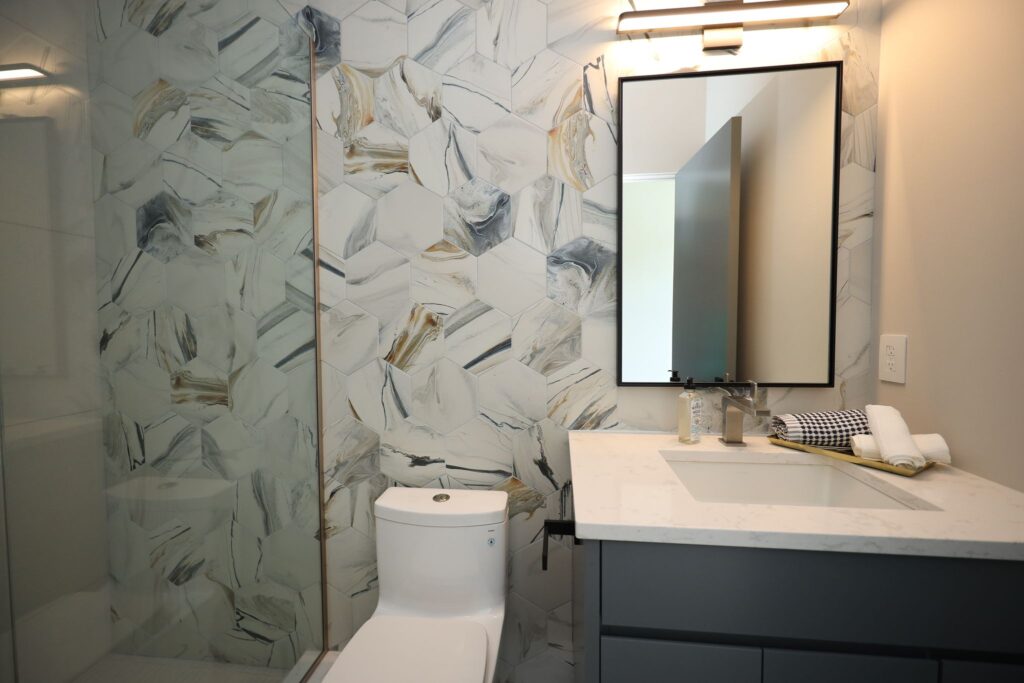
Pattern variety can transform a room’s dynamics, from subtle accents to bold statements. When mixing patterns, it’s vital to balance them to avoid visual noise. Use a limited color palette or repeat elements to create harmony when combining different designs.
Color is more than a visual aspect; it’s an integral part of the home’s language of design. Correctly coordinated, it has the power to evoke emotions, define spaces, and anchor furnishings within an environment.
Customization
Customization in tiling offers limitless possibilities to reflect one’s style and vision. It’s an invitation to infuse a space with individuality and character, ensuring that the final design is as unique as a fingerprint.
With today’s technology, custom tiles can capture any hue, pattern, or texture you imagine. This progression in tile manufacturing allows for bespoke creations that can complement or boldly accentuate the design narrative of a space, offering an exclusive look tailored to your specifications.
Embracing customization means engaging with the tile selection process at a granular level. Consideration must be given to the specific dimensions, edges, finishes, and grout color, all of which contribute significantly to the overall aesthetic and functionality of the tiled surface.
When pursuing a custom tile design, collaboration with experienced artisans and suppliers is critical. They can offer advice on the compatibility of materials and technical requirements, ensuring the custom design not only looks spectacular but also upholds structural integrity and durability.
Remember, a customized tile installation is a piece of art. Each choice in the creative process, from the initial concept to the final placement, contributes to a narrative that will be told for years to come.
Project Management
Meticulous planning ensures project success.
Tile installation is a complex process that warrants dedicated oversight. Success hinges on precise coordination, ranging from the acquisition of the correct volume of materials to adherence to timelines. It necessitates rigorous project management, which is pivotal in navigating the innumerable tasks and decisions involved. Without it, projects can swiftly devolve into logistical nightmares, threatening the intended outcome.
Effectiveness in communication is critically paramount.
Avoid compromising on quality or precision. To ensure seamless execution, the project manager must implement robust quality control protocols. These safeguards are key to maintaining high standards throughout every phase of the installation process, from materials procurement to the meticulous laying of each tile.
The optimal orchestration of activities is integral to maintaining project momentum. This involves not only the effective scheduling of tasks but also ensuring that all stakeholders—from designers to skilled labor—are aligned in their objectives and timelines. Achieving this synergy can often be the determinant between an average outcome and a remarkable creation.
Effective project management is the cornerstone of ensuring seamless and timely installations, avoiding costly mistakes and delays. With the tile industry continuing to innovate and expand, as seen in the Tile Covering’s Market Report 2023, the importance of a skilled project manager has never been more critical. They play an indispensable role in translating an artistic vision into a tangible reality that enhances the allure of the space.
Contact Tiffany Hanken Design
Are you envisioning a space transformed by the unique charm of tiles?
Since its inception, Tiffany Hanken Design has fashioned bespoke interiors, harmonizing form with function, to manifest each client’s vision. The firm’s expertise encompasses a broad spectrum, including tile selection that elevates a space’s aesthetic while ensuring durability and longevity.
As specialists in the intricacies of interior design, we offer comprehensive consultations, guiding you through the vast array of tile materials, patterns, and applications. The commitment to realizing your design aspirations with precision and finesse is our topmost priority.
Embark on your design journey with Tiffany Hanken Design and witness an approach that integrates rigorous planning and creative flair. Engagement at every step, from selection through to installation, guarantees that every detail resonates with your style and stands the test of time.
Contact us to forge a partnership that crafts spaces not only of elegance but of enduring quality and comfort.


